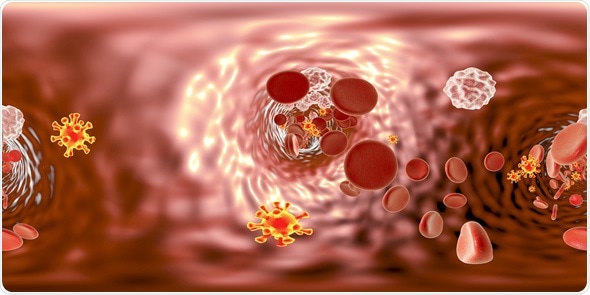
HIV in Children
Human immunodeficiency virus (HIV) infection is the cause of acquired immunodeficiency syndrome (AIDS), a disease that destroys the immune system by attacking white blood cells.
In the US, only around 1% of individuals with HIV are children or adolescents, but worldwide, the disease is much more common, with around 3 million children being infected. Every year, around 330,000 further children are infected each year and 230,000 die as a result.
AIDS is the most severe form of the HIV infection and a child is considered to have developed AIDS once they are suffering fro m at least one complicating illness associated with the infection or when the immune system reaches a certain level of immune suppression based on CD4+ T cell count.

360-degree spherical panorama view of HIV (AIDS viruses) in blood with red blood cells and white blood cells. 3D illustration - Image Copyright: Kateryna Kon / Shutterstock
Transmission
In children, HIV is usually transmitted from the mother before birth, during labor and delivery or after birth, via the mother’s breast milk. This is referred to as vertical or mother-to-child transmission and accounts for over 90% of transmitted infections in children in the US. The remainder become infected through unprotected sexual activity. Blood and blood products were once a significant source of infection, but Improved screening of has meant almost no infections occur as a result of procedures that involve using these in the US, Canada or Western Europe.
About 7000 US women give birth while infected with HIV each year. Without testing and treatment measures, up to 33% of those women would pass the infection on to their baby, usually during labor or delivery. Mothers who become infected during pregnancy or while breastfeeding, those who are severely ill and those who have a high viral load are the most likely to transmit the infection. However, improved preventative measures such as the testing, diagnosis and treatment of infected pregnant women during pregnancy and delivery has led to a significant decline in transmission , from around 25% in 1991 to just 1% in 2009.
HIV can also be transmitted to infants via breast milk, which occurs in around 13% of cases. This is more likely when mothers have a high viral load. The infection is often transmitted in the first weeks or months of the baby’s life, but can be passed on at a later stage. The infection is not transmitted through contact with food, water, household items or social contact.
Symptoms
Children born with HIV do not usually display symptoms during the first few months of life, even if they have not received therapy. Of the children who do not received antiretroviral therapy (ART), only around one-fifth start to develop symptoms in the first two years of life and those children are most likely to have become infected well before birth . Among the remaining 80%, symptoms may not develop until three years or even five years of age and those children are most likely to have become infected around the time of birth.
Children who do not receive treatment commonly develop the following symptoms:
- Delayed growth and maturation
- Recurring diarrhea
- Enlarged lymph nodes
- Enlarged spleen
- Enlarged liver
- Inflamed kidneys
- Oral thrush
- Lung infection
- Anemia
- Weakness and fatigue
Sometimes, children have the following bacterial infections on a recurring basis:
- Middle ear infection
- Pneumonia
- Bacteria in the blood
- Sinusitis
Children with HIV who are treated with ART are significantly less likely to develop bacterial infections or delayed growth than untreated children. However, there does seem to be an increased risk of behavioral and cognitive problems among treated children. It is not yet clear whether this is associated with the HIV medications, the infection itself or other social, psychological or biological factors linked to HIV infection.
Prognosis
Prior to the introduction of ART, around 10 to 15% of HIV-infected children from industrialized countries did not reach the age of 4, and in developing countries this figure was as high as 80%. Nowadays, the availability of ART means that most children survive well beyond 4 years of age and into adulthood.
Sources
- Aids.gov, Children and HIV, www.aids.gov/.../
- MerckManual ConsumerVersion, Human Immunodeficiency Virus (HIV) Infection in Children, www.merckmanuals.com/.../human-immunodeficiency-virus-hiv-infection-in-children
- Advert,Children and HIV/AIDS, www.avert.org/.../children
- MSD Manuals, Professional Version, www.msdmanuals.com/.../human-immunodeficiency-virus-hiv-infection-in-infants-and-children
Further Reading
Last Updated: Aug 23, 2018























.png)









No hay comentarios:
Publicar un comentario